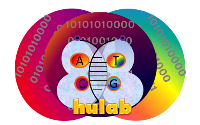Gene Regulation

Surface receptors found on the cell membrane interact with a signaling protein to trigger a cascade of interactions within the cell. In this case, the cascade ends when a protein enters the nucleus of a cell where it can result in the stimulation or inhibition a gene, DNA methylation, histone modification, etc.
Gene Expression:
Genes are transcribed into RNA, so a cell’s gene expression levels can be measured based on the concentration of RNA within a cell. Molecules such as transcription factors, DNA methyl groups, and various histone tags can promote or silence a gene’s activity. Transcription factors bind to DNA promoter regions to stimulate the transcription of a gene. Post-transcriptional regulation can occur when various types of non-coding RNA molecules interact with the mRNA.
Cell Signaling:
Cell signaling has a great influence on a cell's behavior. Proteins outside the cell attach to an integral transmembrane protein that triggers a cascade of interactions. The external stimulus is transported throughout the cell in a series of chemical reactions. These signals can result in gene regulation, cell differentiation, or the release of certain molecules to be used for another reaction.
Chromatin:
Chromatin consists of DNA and various proteins residing in the nucleus of a cell. The basic building blocks of chromatin are called nucleosomes, which are made up of DNA wound around histone octamers and one linker histone.
Chromatin that is gene rich can be classified as euchromatin, while gene poor regions are called heterochromatin. Heterochromatin consists of inactive genes because these regions are found to be more tightly wound thus having less of an effect on an organism’s phenotype. It has been found that expression levels of heterochromatin can be maintained through mitosis, this is seen in calico cat because their coat depends on which X chromosome is inactivated. Although most heterochromatin regions are thought to be inaccessible, high levels of transcription factors can alter chromatin structure to activate genes.
Chromatin that is gene rich can be classified as euchromatin, while gene poor regions are called heterochromatin. Heterochromatin consists of inactive genes because these regions are found to be more tightly wound thus having less of an effect on an organism’s phenotype. It has been found that expression levels of heterochromatin can be maintained through mitosis, this is seen in calico cat because their coat depends on which X chromosome is inactivated. Although most heterochromatin regions are thought to be inaccessible, high levels of transcription factors can alter chromatin structure to activate genes.
Epigenetic Mechanisms:
DNA methylation and histone modification are two important regulators of gene expression. DNA methylation can silence genes through the addition of a methyl group to adenine or cytosine. Histone modifications result in a structural change of the chromatin. Click for More Information on Epigenetic Mechanisms
Resources:

